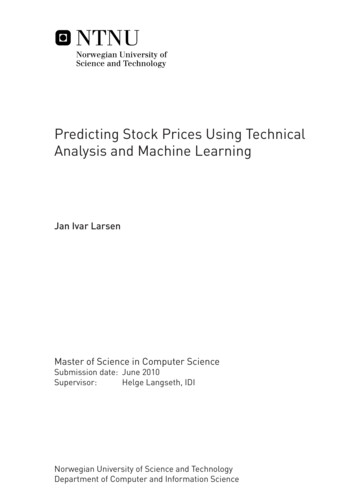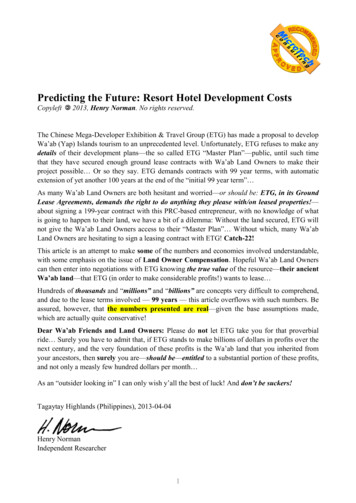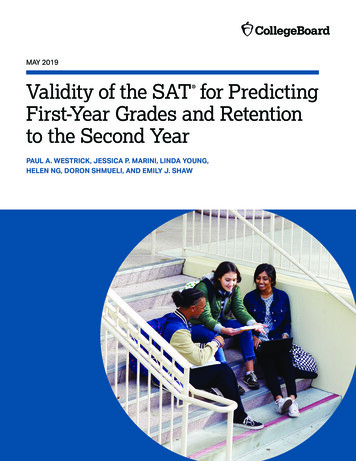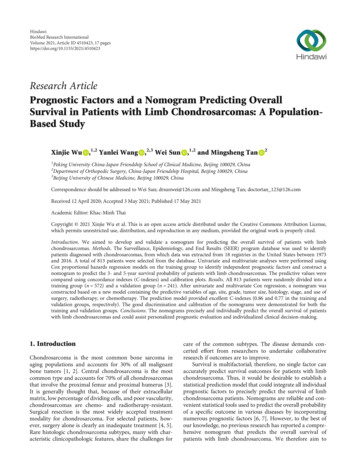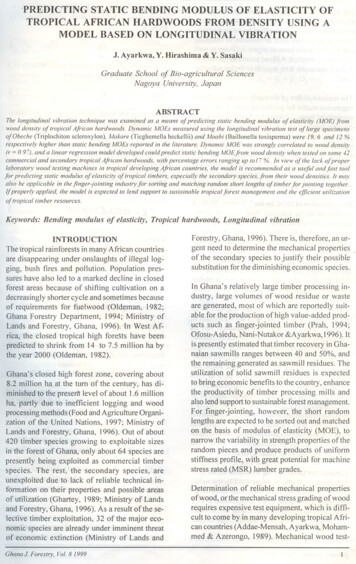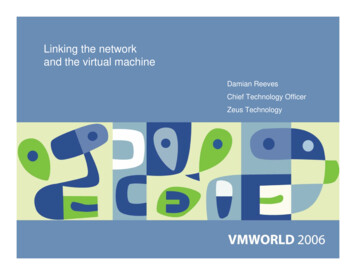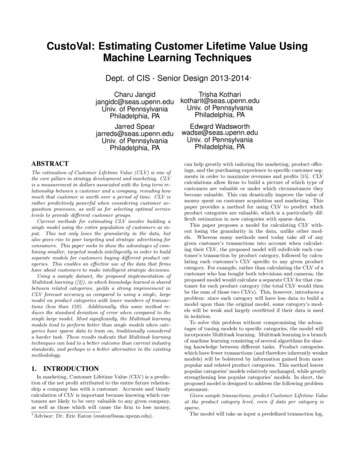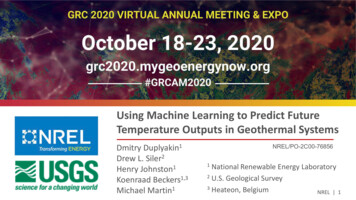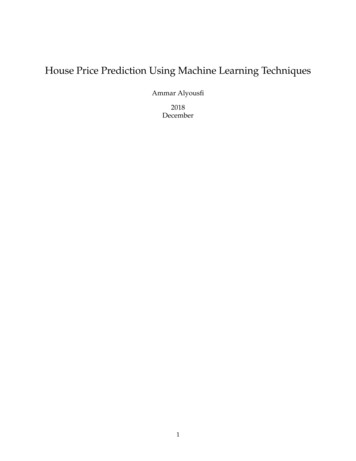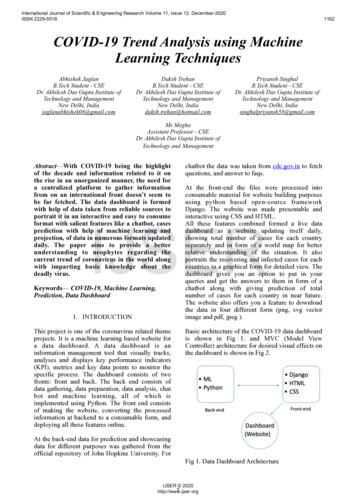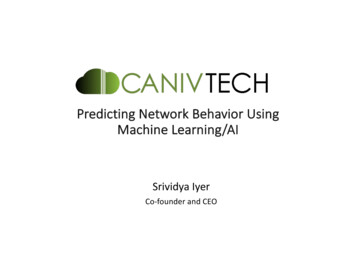
Transcription
Predicting Network Behavior UsingMachine Learning/AISrividya IyerCo-founder and CEO
Why Machine Learning in Networking ? Complexity of application and infrastructure requires newapproaches in network design, operations and management(encrypted data, cloud infrastructure, IoT to name a few) Current solutions - time-series analysis and rule-based heuristicalgorithms - have difficulty scaling. Varied sources of data and knowledge is difficult to process byhumans. ML-based methods can achieve higher prediction accuracy byextracting patterns from data across different vantages.
Building a Machine Learning Use themodel
Frame the Problem ML problems are designed to identify and exploit hiddenpatterns in data and are categorized as follows: Describe the outcome as a grouping of data (Clustering) Predict the outcome of future events (Classification and Regression) The problem you are trying to solve determines Types of data and the amount of data to collect Features to extract ML algorithm to select to train the model Performance metrics used to test the model
Prepare data - Collection Offline - Historical data used for analysis and model training. Online - Real-time network data to adapt the model forchanging network state. Types of data for network applications Flow data (Netflow, sFlow, IPFIX) Packet captures Logs (syslog, firewall) Telemetry Device configurations Network Topology
Prepare data – Feature Extraction Feature extraction is used to reduce dimensionality and toremove features that are irrelevant or redundant. Packet-level features - statistics of packet size, including mean, rootmean square (RMS) and variance, and time series information. Flow level features - flow duration, number of packets per flow,number of bytes per flow Transport level features - Throughput and TCP window size Application specific features (for e.g., DNS, DHCP packet levelfeatures)
Train the Model Data is decomposed into training and test datasets. Common split is 70/30 Need spatial and temporal diversity Once an ML model has been built, gauge the performance Reliability, Robustness, Accuracy, and Complexity. Accuracy is the critical metric in networking applications Computes the difference between the actual and predicted values. There is no way to distinguish a learning algorithm as the“best”
Traffic ClassificationNetworking problemAccurately identifyapplications on thenetworkPurposeDataIdentify P2P Flow data orapplications packet leveltraces withIdentifylabeledCurrent methods – Port unknownapplicationbased or Payload based applications classesAlgorithm(s)SupervisedSupport VectorMachinesDecision TreesRandom Forest
Traffic PredictionNetworkingapplicationAccurately estimatetraffic volumePurposeDataAlgorithm(s)CongestioncontrolFlow data orpacket traceswith derivedstatistics (flowbytes, numberof packets)SupervisedCurrent methods – ResourceTime Series Analysis allocationand NetworkTomographyNeural Networks
Anomaly DetectionNetworking problemIdentify t methods – Rule Malware)and Threshold based,Signature basedDataFlow data(bytes,packets) stering
Fault ManagementNetworkingapplicationAccurately predictfaultsPurposeDataNetworkPacket tracesTroubleshooting(avoid futureTelemetry dataCurrent methods – network failuresManual detectionandLogsand mitigation, Rule performanceand Threshold based degradation)Algorithm(s)SupervisedDecision TreesRandom ForestHybridapproaches ofsupervised/unsupervised
ML for Networking System ComponentsData CollectionDevice setup (TAPs, portmirrors, flow monitorsetc.)Open source a)Commercial toolsFeatureExtractionMachineLearningDomain expertiseAlgorithm selectionPython Pandas/NumpyPython scikit-learnApache SparkDeep Learning(Keras/Tensorflow/pytorch)Data StorageFeatures (Flatfiles,Keystore)Machine Learning models(document/object storage)Reporting (SQL)
Case Study – Traffic Classification Type of Network: Enterprise networks with about 250 to 500 devices. Problem: Port based identification of NetFlow traffic identified about70% of the applications accurately Traffic collected – Netflow v9 From 3 different networks for 7 days in 30minute intervals using nfdump. Data was sampled from different time frame to about 300,000 samplesfor training at 70/30 split. Algorithms tested: Support Vector Machine, Decision Trees and RandomForest using python scikit-learn
Case Study – Traffic Classification - Featuresprotocolsrc portdst 393381921671142
Case Study – Traffic Classification - ResultsApplication labelsprecisionrecallF-1 28112 1.001.001.000.670.80httpmicrosoft-ds75541.00Total Sample: 300000Labeled set: 200000 (Port based)Recall True positive/(True positive False negative)Precision True Positive/(True positive False negative)F-1 score 2 * (Precision*recall)/(Precision recall)
Case Study – Traffic Classification - ConclusionAlgorithm AccuracyTrain setTest setDecision Tree1.000.97Random Forest1.000.98Support Vector Machines1.000.72 Training set sample size matters. There is an optimal sample size beyondwhich there is no improvement. The quality of data decides the accuracy. Different algorithms provide different results Additional data from augmented flows might provide additional insight,but they are not standardized.
Case Study – Fault detection Type of Network: Enterprise networks with about 250 to 500 devices. Problem: Accurately identify the types of faults and performance issuesflying under the radar. Traditional fault management is reactive andinvolves detection, localization and mitigation after it has happened. Traffic collected – Packet captures from 3 different networks for 7 daysin 30 minute intervals using tshark. Data was sampled from different time frames to about 800,000 samplesfor training at 70/30 split. Algorithms tested: Decision Trees and Random Forest using pythonscikit-learn
Case Study – Fault detection- FeaturesLine Load (%)TCPRetransmissionRateTCP DuplicatedAck RateTCP RTT AvgTCP SessionDuration AvgSYN Packet 64710.206470973.418954These values were derived for multiple TCP streamsThis list of features are not exhaustive just illustrative
Case Study – Fault detection- ResultsDataset SizeCategories IdentifiedGeneralizationErrorf1 99626Generalization error is a measure of how accurately an algorithm is able to predict the labels for unseen dataTwo important factors determine generalization ability: Model complexityTraining data size
Case Study – FaultDetection - ConclusionFor training, the number of “normal”vs “fault” samples have to bebalancedPacket traces only gives you networkfaults. Log data needed to correctlyidentify server faults.Control plane telemetry might beuseful to provide additional contextbut could not be collected efficientlyto test it.Both Decision Tree and Randomforest provided similar results.
Challenges - Machine Learning in Networking How to collect the right data and extract features ? Data is inconsistent and messy How to choose the right machine learning method for a specificnetworking problem? There are many ways to approach the traffic prediction, classificationand detection problems. How to make the solution scalable to large and diversenetworks? How to make the ML models learn uniformly across nonuniformly designed networks?
Future Trends ? Data collection SDN/NFV for centralized data collection Open datasets Feature extraction Standardization of training datasets and features for commonnetworking applications Model The robustness of machine learning algorithms Automatic selection of the right algorithm for the right problem. Combining ground truths/models from several vantage points
Questions ?Srividya Iyersiyer@caniv-tech.com@siyeratwork
Background Slides
Artificial Intelligence vs Machine LearningAIMLAI is the ability to make intelligentmachines, that can perceive and act tosatisfy some objective, often without beingexplicitly programmed how to do so.ML is a subset of AI where computerscan learn from real-world examples ofdata. They apply what they've learnt tonew situations – just like humans do.
Machine Learning Terminology Training data – Used by the learning algorithm to “learn” thepatterns in data Learning Algorithm – Used to train the model to learn from data. Supervised - A method where training data includes both the input(features) and the target result (label). There is a label associated to eachclass and the model is trained using the label. Unsupervised – A method where training data only includes theinput(features). The target result is inferred. ML Model - Trained using one or more Machine Learningalgorithms with known data to predict unknown events.
Machine Learning Algorithms Supervised Learning Support Vector Machines Artificial Neural Networks Decision Trees Random Forest Unsupervised K-Means Clustering
ML Algorithms – Support Vector Machines In this example, we are classifying red andblue, based on a given set of features (x,y). SVM takes these data points and outputsthe hyperplane that best separates red andblue. This line is the decision boundary:anything that falls to one side of it will beblue and anything that falls to the other asred. Support vectors (indicated by circles) arethe data points that lie closest to thedecision boundary (or hyperplane)
ML Algorithms – Neural Networks Neural networks are made up of manyartificial neurons.Each input into the neuron has its ownweight associated with itThe inputs may be represented as x1, x2,x3 xn.And the corresponding weights for theinputs as w1, w2, w3 wn.Output a x1w1 x2w2 x3w3. xnwnSource:web2.utc.edu/ djy471/documents/b2.2.MLP.ppt
ML Algorithms – Decision Trees A decision tree maps the input to thedecision value by performing a sequence oftests on the different feature values. For a given data instance, each internalnode of the tree tests a single feature valueto select one of its child nodes. This process continues till leaf node isreached which assigns the final decisionvalue to the instance.Source: www.cs.cmu.edu/ awm
ML Algorithms – Random Forest Random forest is an ensemble classifier thatconsists of many decision trees. Ensemble methods use multiple learningmodels to gain better predictive results. In Random forest, the model creates anentire forest of random uncorrelateddecision trees to arrive at the best possibleanswer. Bagging: Train learners in parallel on differentsamples of the data, then combine the results.Boosting: Train learners on the filtered outputfrom other learners.Diagram Source: lgorithm-d457d499ffcd
ML Algorithms – K-Means Clustering One method to train a data set withoutlabels is to find groups of data which aresimilar to one another called clusters. K-Means is one of the most popular"clustering" algorithms. K-means stores “k” centroids that it uses todefine clusters. A point is considered to be in a particularcluster if it is closer to that cluster'scentroid. Clustering results are dependent on themeasure of similarity (or distance) between“points” to be clusteredSource: www.cs.cmu.edu/ awm
Jun 11, 2019 · Flow data (Netflow, sFlow, IPFIX) Packet captures Logs (syslog, firewall) Telemetry Device configurations Network Topology. Prepare data –Feature Extraction Feature extraction is used to reduce dimensionality
